In our previous episode, our intrepid naturalist along with his wife Dayna and sister Lori were at Big Spring, about 9:30 p.m., braving the threat of an approaching thunderstorm and wandering through a series of sloughs, searching for breeding salamanders and hoping to find a wandering Devil Crayfish (Cambarus diogenes) in the process. Successful in finding a breeding mass of salamanders, our explorers had just regrouped to look at the two crayfish they had caught and placed in a bucket without examining. Expecting to see either the afore mentioned C. diogenes or perhaps Orconectes punticmanus (the spot-handed crayfish, which can also occasionally be found in sloughs,) our adventurers were in for a surprise…
In the beam of the flashlight, was a large (4”) crayfish (and a second somewhat smaller individual.) But instead of an olive colored crayfish with stout, heavy claws, this crayfish was reddish-brown with a black wedge on the abdomen and long, slender claws. It was one of the lowland Procambarus species, but I wasn’t sure which yet. The most likely was P. acutus (the White River Crayfish,) but P. viaeviridus (the Vernal Crayfish) is very similar in appearance (though 4” would be a huge P. viaeviridus.) And there was an slight chance it was a P. clarkii (Red Swamp Crayfish,) but the coloring was wrong. Neither of the three were known from the park or even the Current River upstream of the Doniphan area as far as I can determine, so I was pretty excited at this point.
Back at home, I started eliminating species. The areola was present which definitely eliminated P. clarkii which has no areola. The size of the larger specimen had me convinced that it was was a P. acutus, and the granulated texture on the carapace and the shape of the rostrum and acumen confirmed it. Now P. acutus is a wide-ranging species occurring all along the Atlantic and Gulf coast and up the Mississippi valley to the Great Lakes, so I had hardly found anything rare. But it was new to the park and appears to be a county record too.
Two days later, I talked my brother-in-law Billy into going back to Big Spring with me to see if there were more crayfish in the other sloughs strung out upstream along the old river channel. We found three more individuals in the first slough, but struck out in the upstream sloughs even though they appeared to be suitable habitat. The only difference I could think of was that the slough where we actually found crayfish did not dry up last fall, while all of the others did and only had refilled with the rains that came at the end of February. But P. acutus burrows to escape drying and I had found burrows here last fall, without the chimney characteristic of those of C. diogenes, so that shouldn’t eliminate them from the sloughs that had dried out.
Thinking of those burrows finally triggered the memory that I had found two odd crayfish in the same area last fall. They were very small – neither was as much as 1/2″ – and looked way too slender to be Cambarus diogences, the burrowing crayfish I had assumed them to be. Not thinking there was a chance of another species showing up in the area, I had simply collected one and stuck it in the freezer without looking at it really closely.
Pulling it out of the freezer, I put it under a magnifying lamp to have a look. Sure enough, a very close match to the photo of a juvenile P. acutus in Pflieger’s Crayfish of Missouri.
Sorry for the poor quality of the photo – this was a very small crayfish that was nearly impossible to pose – and I managed to screw up the white balance too. It doesn’t show in the photo, but there was the beginnings of the dark wedge on the abdomen.
So here we have pretty good evidence of a breeding population, one that I believe is a natural range extension since the species has been recorded approximately 35 miles downstream. Now all I have to do is search all of the sloughs and backwaters along the river down to the park boundary at the Carter-Ripley county line and see if this is an isolated population or if there are more lurking about. I’d be surprised if I don’t find more of them.
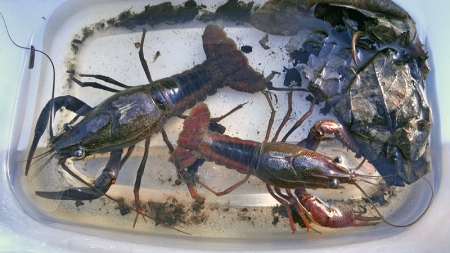
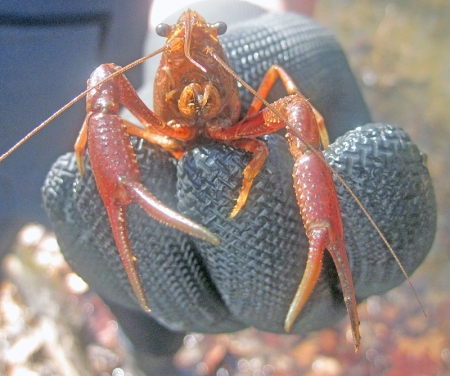
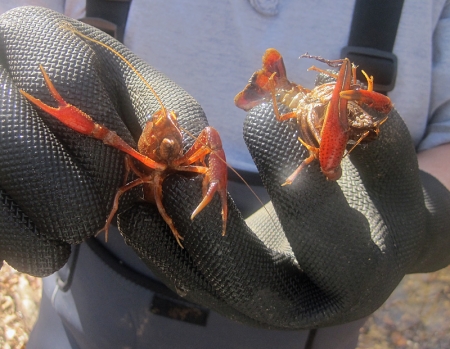
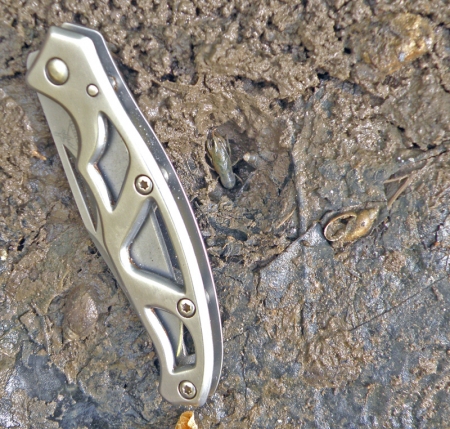
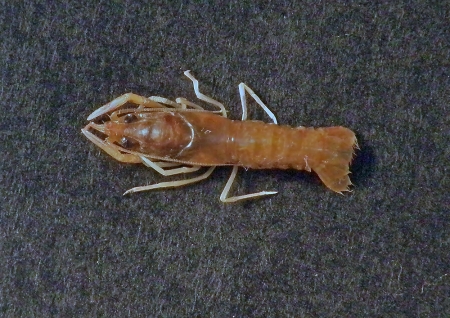
Mr. Swofford,
I’m enjoying your crayfish tales (no pun intended)on this web site. Your finding (above) of Procambarus acutus in Big Spring does cause me some concern. As you noted, Pleifger (1996) noted a couple occurrences of this species further downstream. However, in the past few years we have documented several introductions (probably but not necessarily “baitbucket introductions”)of this species in several locations around the state. In those locations, the species appears to have displaced native crayfish species. I was glad to read that you were finding it in the sloughs and not out in the mainstem. I’m certainly willing to believe that this is a natural occurrence, but am a bit nervous about this species at present.
Anyway, if you happen to find this species (P. acutus) or any other crayfish species “surprises” in locations that seem odd, we’d be very interested in hearing about them (including specific locality information). We have documented 21 alien crayfish invasions in Missouri in the past few years and we are trying to get a handle on this problem.
Anyway, a couple of us up here in Columbia that work on Missouri’s crayfishes are enjoying your site, and aprreciate your enthusiasm and dedication! Keep it up!
Sincerely,
Bob DiStefano
Missouri Dept. Conservation
Mr. Swofford,
I forgot to leave my contact information:
Bob.DiStefano@mdc.mo.gov
Feel free to contact me anytime. Thanks.
Bob
My students collected macroinvertebrates at Jordon Creek (Springfield) last week, and got some tiny crayfish, about 1/2″ long and clear. Very cute. What is the species, do you know?
Thanks!
Lianne
Hi Lianne,
I can’t tell you for sure without seeing them (and may even if I did see them,) but they’re most likely Orconectes neglectus or Ringed Crayfish. The James River basin also has O. ozarkae, O. longidigitus and Cambarus hubbsi, but I’d guess O. neglectus that far up towards headwaters.
Thanks,
Dan